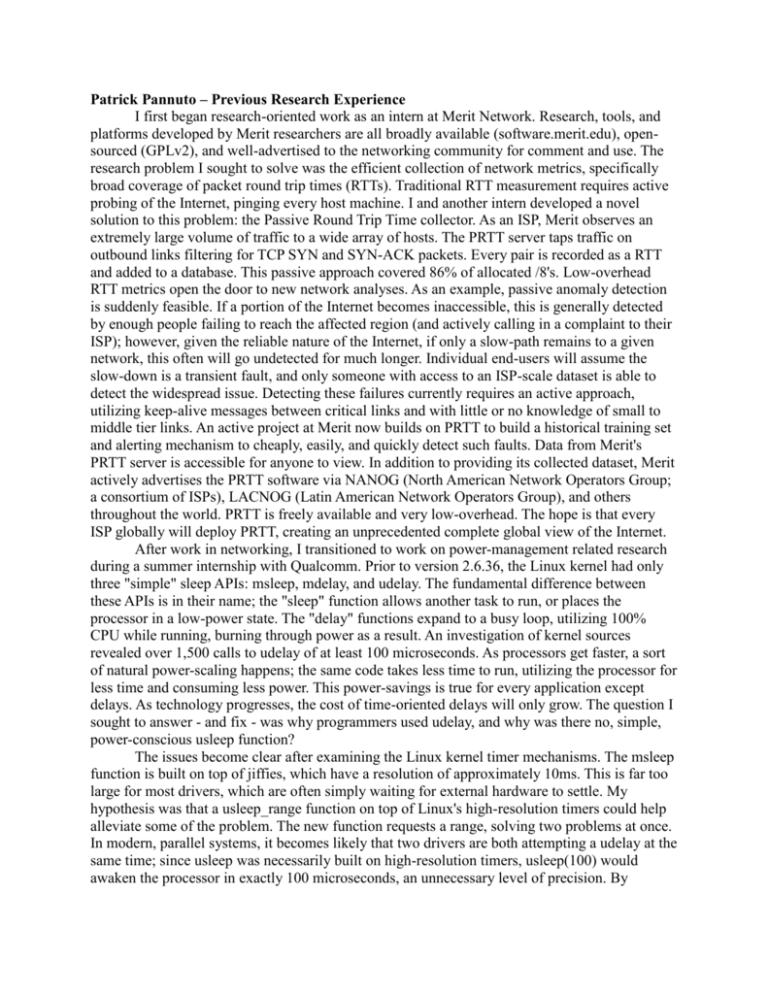doc - Pat Pannuto
advertisement

Patrick Pannuto – Previous Research Experience I first began research-oriented work as an intern at Merit Network. Research, tools, and platforms developed by Merit researchers are all broadly available (software.merit.edu), opensourced (GPLv2), and well-advertised to the networking community for comment and use. The research problem I sought to solve was the efficient collection of network metrics, specifically broad coverage of packet round trip times (RTTs). Traditional RTT measurement requires active probing of the Internet, pinging every host machine. I and another intern developed a novel solution to this problem: the Passive Round Trip Time collector. As an ISP, Merit observes an extremely large volume of traffic to a wide array of hosts. The PRTT server taps traffic on outbound links filtering for TCP SYN and SYN-ACK packets. Every pair is recorded as a RTT and added to a database. This passive approach covered 86% of allocated /8's. Low-overhead RTT metrics open the door to new network analyses. As an example, passive anomaly detection is suddenly feasible. If a portion of the Internet becomes inaccessible, this is generally detected by enough people failing to reach the affected region (and actively calling in a complaint to their ISP); however, given the reliable nature of the Internet, if only a slow-path remains to a given network, this often will go undetected for much longer. Individual end-users will assume the slow-down is a transient fault, and only someone with access to an ISP-scale dataset is able to detect the widespread issue. Detecting these failures currently requires an active approach, utilizing keep-alive messages between critical links and with little or no knowledge of small to middle tier links. An active project at Merit now builds on PRTT to build a historical training set and alerting mechanism to cheaply, easily, and quickly detect such faults. Data from Merit's PRTT server is accessible for anyone to view. In addition to providing its collected dataset, Merit actively advertises the PRTT software via NANOG (North American Network Operators Group; a consortium of ISPs), LACNOG (Latin American Network Operators Group), and others throughout the world. PRTT is freely available and very low-overhead. The hope is that every ISP globally will deploy PRTT, creating an unprecedented complete global view of the Internet. After work in networking, I transitioned to work on power-management related research during a summer internship with Qualcomm. Prior to version 2.6.36, the Linux kernel had only three "simple" sleep APIs: msleep, mdelay, and udelay. The fundamental difference between these APIs is in their name; the "sleep" function allows another task to run, or places the processor in a low-power state. The "delay" functions expand to a busy loop, utilizing 100% CPU while running, burning through power as a result. An investigation of kernel sources revealed over 1,500 calls to udelay of at least 100 microseconds. As processors get faster, a sort of natural power-scaling happens; the same code takes less time to run, utilizing the processor for less time and consuming less power. This power-savings is true for every application except delays. As technology progresses, the cost of time-oriented delays will only grow. The question I sought to answer - and fix - was why programmers used udelay, and why was there no, simple, power-conscious usleep function? The issues become clear after examining the Linux kernel timer mechanisms. The msleep function is built on top of jiffies, which have a resolution of approximately 10ms. This is far too large for most drivers, which are often simply waiting for external hardware to settle. My hypothesis was that a usleep_range function on top of Linux's high-resolution timers could help alleviate some of the problem. The new function requests a range, solving two problems at once. In modern, parallel systems, it becomes likely that two drivers are both attempting a udelay at the same time; since usleep was necessarily built on high-resolution timers, usleep(100) would awaken the processor in exactly 100 microseconds, an unnecessary level of precision. By requesting a range, programmers can better express their actual needs, allowing the scheduler to coalesce timer wake-ups from various processes, waking the processor less often. Adapting the Qualcomm drivers to utilize the new usleep_range function converted approximately 7,700 microseconds per second of busy wait (100% CPU) to idle state (0% CPU) during active usage. To bolster community adoption, I added documentation targeted at driver writers to the kernel tree and added a "Checkpatch" rule to alert new authors to the new API when it detected use of the old udelay mechanism. As of the Linux 3.0 kernel, there are over 180 different users of the new function, saving microwatts of power in every Linux-powered device around the globe. After internships, I found opportunity to do some undergraduate research, an exploration into the current state of Power Line Communications (PLC). PLC has made some small headway into consumer networking as well as the distributed power metering apparatus, but the technology has not achieved any serious penetration. The motivating factor for the work was an investigation of building load monitoring. Oddly, all existing technologies (Kill-A-Watt, ACme, etc) communicated over wireless. In these systems, monitoring nodes were plugged into outlets all over a building in which one centralized receiver node was also plugged in. The system would then construct a complicated multi-hop wireless mesh network to communicate, despite all being plugged into the same physical power supply grid. The question I sought to answer then was (1) why PLC technology has not yet seen great adoption and (2) specifically why it has not seen adoption in a space that would seem ideally suited to the technology. In seeking answers, it quickly became apparent that there was very little data immediately available to the research community on PLC. As I collected information, a survey paper naturally evolved from the work. The paper first explored a brief history of PLC technology; it then progressed to explain how modern PLC technology functioned, how it achieved its data rates, and most importantly its limitations. I could find no documentation or resource that would accurately define the limits of PLC technology, so I resorted to experimentation. I purchased several PLC modems and in conjunction with a copy of the building's electrical blueprints began running connectivity testing. The results were both promising and disheartening. PLC connectivity is fantastic - until you reach a transformer. Whether or not PLC signals can cross a transformer relies heavily on what type of transformer it is as well as where you are trying to cross. As an example, PLC signals almost always coupled successfully to another phase leg on the same side of a transformer, but crossing the inductive gap was significantly less reliable. It was this limitation that explained the bounds of current PLC penetration. PLC has succeeded in homes where consumers are unlikely to have a transformer to interrupt signals; in commercial buildings, such as the one where the power metering research was performed, much more intimate knowledge of the building's power network is required to achieve connectivity. I presented the work at the Low Power and Lossy Networks Workshop at IPSN 2011. The workshop concluded with a roundtable on the future of low power networking; my PLC presentation made the discussion of varied PHY layers a first class citizen. As a follow-up to this work, I am currently working on adapting a PLC modem to a TelosB mote with the TinyOS stack to hopefully build an interpretable power line and 802.15 network. In conclusion, my previous research has had a broad, positive impact in a variety of fields facilitating new classes of network research, a global improvement in Linux power efficiency, and the exploration of a new class of communications for sensor networks. Presentations and Publications: NANOG 50: (presentation) IRR - Additional Route Attributes IPSN 2011: (presentation and publication) Exploring Powerline Networking for the Smart Building





